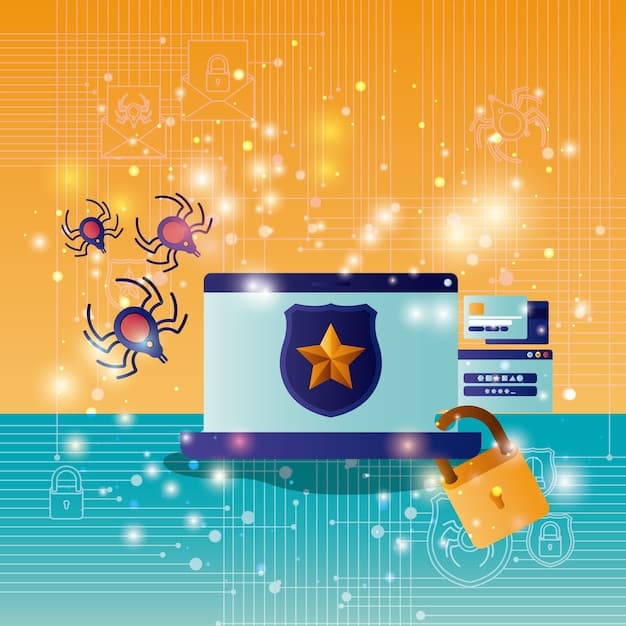Digital Payment Security: Protect Your Business in 2025

In 2025, securing digital payments is crucial for US businesses; this article outlines seven essential steps, including strong encryption, multi-factor authentication, regular security audits, employee training, fraud monitoring, compliance adherence, and incident response planning, to protect against cyber threats.
In the ever-evolving landscape of digital commerce, ensuring the security of online transactions is paramount, especially for businesses operating in the US. As we approach 2025, the sophistication and frequency of cyber threats continue to escalate, making robust digital payment security measures essential for safeguarding your business’s financial stability and reputation.
Understanding the Digital Payment Security Landscape in 2025
The digital payment landscape is constantly shifting, with new technologies and threats emerging regularly. To effectively protect your business, it’s crucial to understand the current state of payment security and the challenges that lie ahead. This section provides an overview of the key trends and vulnerabilities impacting digital payments.
Emerging Cyber Threats
Cybercriminals are becoming increasingly sophisticated in their tactics. Some of the emerging threats include:
- Ransomware Attacks: Targeting payment systems to extort money from businesses.
- Phishing Scams: Deceiving customers into revealing their payment information.
- Supply Chain Attacks: Compromising third-party vendors to gain access to payment data.
- AI-Powered Fraud: Using artificial intelligence to automate and scale fraudulent activities.
Understanding these threats is the first step in developing a strong security posture.
Key Regulations and Standards
Staying compliant with industry regulations and standards is crucial for maintaining customer trust and avoiding penalties. Some key regulations include:
- PCI DSS (Payment Card Industry Data Security Standard): A set of security standards for organizations that handle credit card information.
- CCPA (California Consumer Privacy Act): Protecting the privacy rights of California residents.
- GDPR (General Data Protection Regulation): Although based in Europe, it affects US companies dealing with European customers’ data.
Compliance with these regulations demonstrates your commitment to protecting customer data.

In conclusion, the digital payment landscape is dynamic and complex, requiring businesses to stay informed and proactive to protect against evolving threats. By understanding the risks and adhering to industry standards, you can build a strong foundation for secure digital payments.
Step 1: Implement Strong Encryption Protocols
Encryption is the cornerstone of secure digital payments. By encrypting sensitive data both in transit and at rest, you can prevent unauthorized access and protect customer information from being compromised.
Strong encryption protocols transform readable data into unreadable code, making it virtually impossible for cybercriminals to decipher it. Here’s how to implement effective encryption:
Data Encryption in Transit
Use secure protocols like Transport Layer Security (TLS) to encrypt data as it travels between your systems and your customers’ devices. Key considerations include:
Implement HTTPS on your website to encrypt all communication between your website and your customers’ browsers.
- Regularly update your TLS certificates to ensure they are valid and secure.
- Use strong cipher suites that are resistant to known vulnerabilities.
Data Encryption at Rest
Encrypt sensitive data stored on your servers and databases. Options include:
- Full-disk encryption to protect entire storage volumes.
- Database encryption to secure specific data fields.
- Tokenization to replace sensitive data with non-sensitive tokens.
By implementing strong encryption, you can significantly reduce the risk of data breaches and protect your customers’ financial information.
To conclude, strong encryption mechanisms are paramount in safeguarding digital payments. Staying informed about the latest encryption best practices will significantly enhance the security of your payment processes.
Step 2: Enforce Multi-Factor Authentication (MFA)
Multi-Factor Authentication (MFA) adds an extra layer of security to your payment processes. By requiring users to provide multiple forms of identification, you can prevent unauthorized access even if their passwords are compromised.
MFA requires users to provide two or more verification factors to access their accounts. Here’s how to implement MFA effectively:
Types of Authentication Factors
Consider using a combination of the following factors:
- Something they know (password, PIN).
- Something they have (security token, smartphone).
- Something they are (biometric data, fingerprint).
Combining these factors makes it much harder for attackers to gain unauthorized access.
Implementing MFA for Payment Processes
Enforce MFA for all users who have access to sensitive payment data:
Require customers to use MFA when making online purchases.
- Implement MFA for employees who have access to payment processing systems.
- Use MFA for administrative accounts to prevent unauthorized changes to payment settings.
By enforcing MFA, you can significantly reduce the risk of unauthorized access to payment data.
In conclusion, MFA is a simple yet effective way to enhance the security of your digital payment processes. Ensuring MFA is properly implemented will provide a much-needed layer of protection against unauthorized access.
Step 3: Conduct Regular Security Audits and Penetration Testing
Regular security audits and penetration testing help you identify vulnerabilities in your payment systems and address them before they can be exploited by cybercriminals. Proactive testing ensures your security measures are up-to-date and effective.
Security audits and penetration testing are essential for identifying and addressing vulnerabilities in your payment systems. Here’s how to conduct effective assessments:
Security Audits
Conduct regular audits of your payment systems to ensure they comply with industry standards and regulations.
- Review your security policies and procedures.
- Examine your access controls and permissions.
- Assess your data encryption and storage practices.
Addressing the findings from these audits will help you maintain a strong security posture.
Penetration Testing
Hire ethical hackers to simulate real-world attacks on your payment systems. Key benefits include:
- Identifying vulnerabilities that could be exploited by attackers.
- Testing the effectiveness of your security controls.
- Providing recommendations for improving your security posture.

By regularly conducting security audits and penetration testing, you can identify and address vulnerabilities before they are exploited by cybercriminals.
Step 4: Train Employees on Payment Security Best Practices
Your employees are often the first line of defense against cyber threats. Training them on payment security best practices can help them identify and avoid phishing scams, social engineering attacks, and other security risks.
Employee training is a crucial component of a comprehensive security strategy. Here’s how to train your employees effectively:
Phishing Awareness Training
Teach employees how to recognize and avoid phishing emails:
- Explain the characteristics of phishing emails (e.g., suspicious sender addresses, grammatical errors, urgent requests).
- Conduct simulated phishing attacks to test their awareness.
- Encourage them to report suspicious emails to the IT department.
Password Security Training
Educate employees on the importance of strong passwords:
Encourage employees to use long, complex passwords that are difficult to guess.
- Advise against reusing passwords across multiple accounts.
- Promote the use of password managers to securely store and generate passwords.
In conclusion, investing in employee training is a cost-effective way to improve your overall security posture. An informed and vigilant workforce can significantly reduce the risk of payment fraud and data breaches.
Step 5: Implement Fraud Monitoring and Detection Systems
Real-time fraud monitoring and detection systems can help you identify and prevent fraudulent transactions before they impact your business or your customers. Early detection is key to minimizing losses and protecting your reputation.
Fraud monitoring and detection systems are essential for identifying and preventing fraudulent transactions. Here’s how to implement effective systems:
Real-Time Monitoring
Monitor payment transactions in real-time for suspicious activity:
- Flag transactions with unusual amounts or destinations.
- Track transactions from high-risk countries or IP addresses.
- Monitor for multiple transactions from the same device or account.
Anomaly Detection
Use machine learning algorithms to detect anomalous patterns in payment data:
Establish baseline behavior patterns for each customer or account.
- Flag transactions that deviate significantly from these patterns.
- Continuously update your algorithms to adapt to new fraud trends.
By implementing fraud monitoring and detection systems, you can minimize losses and protect your customers from fraudulent activity.
To conclude, real-time fraud detection systems are more critical than ever. Implementing them effectively keeps your business and customers more secure.
Step 6: Ensure PCI DSS Compliance and Stay Updated on Regulations
Compliance with Payment Card Industry Data Security Standard (PCI DSS) is not just a requirement but a critical step in maintaining payment security. Equally important is staying abreast of changing regulations that impact how you handle financial data.
PCI DSS is a set of security standards designed to protect credit card data. Here’s how to maintain compliance:
Regular Assessments
Conduct regular self-assessments or hire a Qualified Security Assessor (QSA) to validate your compliance:
- Identify gaps in your security controls.
- Develop a remediation plan to address these gaps.
Stay Updated
Keep up-to-date with the latest changes to the PCI DSS standards and regulations:
- Subscribe to industry newsletters and alerts.
- Attend webinars and conferences on payment security.
Staying compliant with PCI DSS and other regulations demonstrates your commitment to protecting customer data.
In conclusion, PCI DSS compliance serves as a cornerstone in the landscape of digital payments. Regularly reviewing and updating your compliance strategy ensures you have strong foundations for security.
Step 7: Develop an Incident Response Plan
Even with the best security measures in place, data breaches and cyberattacks can still occur. Having a well-defined incident response plan in place can help you minimize the impact of these incidents and quickly restore normal operations. Preparation is key to effective response.
An incident response plan outlines the steps to take in the event of a security breach. Here’s how to develop an effective plan:
Identify Key Stakeholders
Assemble a team of stakeholders from different departments:
- IT security.
- Legal.
- Public relations.
Define Response Procedures
Outline specific procedures for responding to different types of incidents:
Contain the incident to prevent further damage.
- Eradicate the threat from your systems.
- Recover data and restore normal operations.
- Notify affected parties as required by law.
By having a well-defined incident response plan in place, you can minimize the impact of security breaches and quickly restore normal operations.
In conclusion, a comprehensive incident response plan ensures preparation for possible security incidents. Having an effective plan ensures you know how to mitigate any damage.
| Key Point | Brief Description |
|---|---|
| 🛡️ Encryption | Secures data in transit and at rest, preventing unauthorized access. |
| 🔑 MFA | Adds an extra layer of security by requiring multiple verification factors. |
| 🔍 Security Audits | Identifies vulnerabilities through regular assessments and penetration testing. |
| 🚨 Incident Plan | Outlines steps to minimize the impact of security breaches for quick recovery. |
Frequently Asked Questions
▼
Digital payment security protects your business from financial losses, data breaches, and reputational damage. It also ensures customer trust and compliance with regulatory standards.
▼
MFA requires users to provide multiple verification factors, like a password and a security code, adding an extra layer of protection against unauthorized access, even if the password is compromised.
▼
You should conduct security audits at least annually and penetration testing more frequently, depending on the size and complexity of your business and the sensitivity of the data you handle.
▼
Employees are often the first line of defense. Training them on best practices helps them recognize and avoid phishing scams, social engineering attacks, and other security risks that may lead to a breach.
▼
An incident response plan should include key stakeholders, defined procedures for responding to breaches, steps for containing the incident, eradicating threats, and recovering data to restore normal operations fast .
Conclusion
As we look towards 2025, prioritizing digital payment security is crucial for safeguarding your US business from evolving cyber threats. By implementing these seven key steps – strong encryption, multi-factor authentication, regular security audits, employee training, fraud monitoring, compliance, and an incident response plan – you can build a resilient defense against fraud and data breaches.





